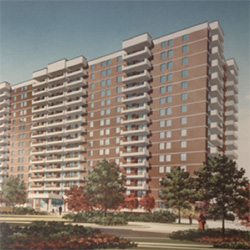If you want a 100% smoke-free building from the outset, including a no-smoking policy in the declaration prior to selling any units is the simplest way forward. This avoids the problems, costs and fire risks of maintaining a building where smoking is permitted.
“Green” construction is on the rise with more buildings becoming LEED (Leadership in Energy and Environmental Design) certified. A 100% smoke-free environment is perhaps the easiest and least expensive way that a developer can improve the quality of indoor air in a building.
To create a policy that works for your building, consider who the policy will apply to, where it will apply, what will be regulated, when it will come into effect and how it will be enforced. A smoke-free policy in a condominium’s declaration can include many forms, so it is important to clearly specify which areas will be designated as non-smoking.
No-smoking options include:
- All units
- All units including balconies and patios
- Within a certain distance such as 9 metres from doorways, operable windows and air intakes
- On outdoor common areas such as patios, swimming pools, gardens
- On the entire condominium property, up to the property line
Developers also have the choice to provide a designated outdoor smoking area if the size of the property allows it. Ideally, such an area would have a roof, somewhere to sit, somewhere to dispose of cigarette butts safely, and would be located well away from outdoor common areas like pathways and patios. Keep in mind the nature and layout of the complex and ensure the policy protects the health of residents.
Regardless of the scope of the policy chosen, it must comply with relevant legislation, including the Condominium Act, 1998 and the Ontario Human Rights Code.
Consider who the policy will apply to. No-smoking policies should apply to residents, visitors, invited guests, staff, service providers and contractors, as well as managers. Usually residents are responsible for advising guests and visitors about where they can and cannot smoke.
Think about what substances you want to include in your policy and provide a clear definition. The Smoke-Free Ontario Act prohibits smoking of tobacco and cannabis and vaping of any substances in common areas of multi-unit housing. You may want to consider the same or different substances.
Decide on a start date for the policy. Six months to a year should be enough time to gather required information and prepare for the policy. Spring and summer are ideal times to launch a new policy–that gives people enough time to get used to stepping outside for a cigarette before the snow flies!
- Draft the declaration. See a sample no-smoking policy
- Seek legal advice;
- Register the declaration at an appropriate registry office.
Existing Buildings
A no-smoking policy can apply to an existing condominium via an change to the declaration or the passing of a bylaw or policy. It is a good idea to do the groundwork before taking this to the general condominium membership. It will be important to build support for the issue–make sure you are prepared in advance of attending any board of directors’ meetings, owners’ meetings or an annual general meeting. Be prepared to address resident concerns and opposition. Building support may result in the best outcome.
It is important to convey that a no-smoking policy is not about targeting or passing judgment on smokers, but about protecting non-smokers from the known health hazards of exposure to second-hand smoke.
Download How to implement a no-smoking policy for a multi-unit dwellings: A protocol for condominiums or housing co-operatives in Ontariofor steps to take for your building.
Consider the scope and type of policy
A no-smoking policy can include many differences, so it is important to clearly specify which areas will be designated as non-smoking. Ideally, survey results will help to guide the scope of the policy. Examples include:
- In private units only;
- In private units including private use balconies or patios;
- Within a certain distance (e.g. 9 m) from doorways, operable windows and air intakes;
- Outdoor common areas such as patios, swimming pools, gardens, etc.;
- On the entire condominium property, up to the property line.
You also have the choice to provide a designated outdoor smoking area if the size of the property allows it. Ideally, such an area would have a roof, somewhere to sit, somewhere to dispose of cigarette butts safely, and would be situated well away from outdoor common areas like pathways, patios, etc. In choosing the appropriate policy for the complex, it is important to keep in mind the nature and layout of the complex, and ensure the policy is connected to protecting the health of residents.
Regardless of the scope of the policy chosen, it must comply with relevant legislation, including the Condominium Act, 1998 and the Ontario Human Rights Code.
“Grandparenting” provisions
In Ontario there is no legal requirement for a condominium corporation to “grandparent” (exempt) current unit owners who are not supportive of a no-smoking policy. A grandparent provision could be for a specified length of time (i.e. smoking will continue to be permitted for 6 months or one year) or for the duration of the ownership of the unit until the unit is sold.
If there are no residents in the building who smoke, it may be easy to create a policy where there is a complete ban on smoking without a grandparent clause. On the other hand, there may be unit owners in the building who are in favour of a no-smoking policy only if it includes a grandparent provision. It could be difficult to pass a no-smoking policy if it is strict and offers no adjustment time for people who smoke. At the same time, a policy that grandparents unit owners will not offer relief to residents who are suffering from involuntary second-hand smoke exposure.
Declaration amendment or rule
Declaration amendment
Declaration amendments require a minimum of 80% of eligible unit owners to vote in favour of the declaration change, so clearly this is neither the fastest nor easiest route to a no-smoking policy for a condominium. However, this option has the best chance of sticking as it would require an 80% vote to get rid of the policy.
A declaration amendment needs the board of directors to approve it by motion, at which point a notice with the suggested change would be sent out to all eligible unit owners. The board would then call an owners’ meeting to discuss the proposed change. Following the meeting, eligible owners submit written votes. If at least 80% of eligible owners vote in favour, the change must then be registered at a registry office within 30 days of the notice being sent out. Once registered, the change is in effect.
Rules
The board of directors can make rules regarding the use of the common elements and the units to:
(a) promote the safety, security or welfare of the owners and of the property and assets of the corporation; or
(b) prevent unfair interfering with the use and enjoyment of the common elements, the units or the assets of the corporation.
Rules take effect 30 days after notice is given to eligible unit owners. However, a minimum of 15% of eligible owners can request the board to call a meeting to consider the rule. A rule then becomes effective once approved at the meeting by owners of 25% of the units.
It is likely that the rules, which are most easily passed and changed, would be used to limit or ban smoking in a condominium. However, given that the owners of just a quarter of the units can make or break a rule, it is possible that a no-smoking rule might not have sticking power the way a declaration amendment would.






